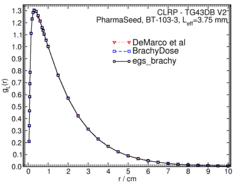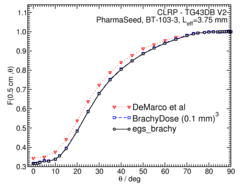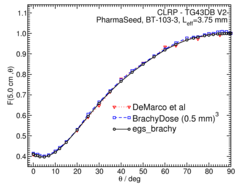
ource Description:
Dimensions for the PharmaSeed BT-103-3 source are taken from the study by DeMarco et al 1 . The Syncor BT-103-3 103Pd seed contains four spherical polystyrene beads with a diameter of 0.550 mm. The polystrene beads are coated with 0.50 μm of 103Pd. The four beads are separated into two pairs by a gold marker that is 0.50 mm in diameter and 1.10 mm long. Calculations are done with the internal spheres arranged in the "ideal" configuration (The centers of the four beads offset ± 1.60 mm and ± 0.95 mm from the source center). The source is encapsulated in a titanium casing 0.050 mm thick with an outside diameter of 0.80 mm. The end welds have a maximum thickness of 0.240 mm and are modelled using a 0.40 mm radius Ti hemisphere overlapped with a 0.350 mm radius air sphere with its center shifted by 0.190 mm relative to the Ti sphere. The overall source length is 4.50 mm and the active length used in our model is 3.75 mm. The maximum possible displacement of a source sphere is 0.72 mm along the source axis and 0.075 mm in the radial direction, however, we assume the two beads are always centred. The mean photon energy calculated on the surface of source is 20.50 keV with mean statistical uncertainties < 0.01% .
Dose-Rate Constant - Λ :
Dose-rate constants, Λ , are calculated by dividing the dose to water per history in a (0.1 mm)3 voxel centered at the reference position, (1 cm,Π/2), in the 30x30x30 cm3 water phantom, by the air-kerma strength per history (scored in vacuo ). As described in ref. 2 , dose-rate constants are provided for air-kerma strength calculated using voxels of 2.66x2.66x0.05 cm3 (WAFAC) and 0.1x0.1x0.05 cm3 (point) located 10 cm from the source. The larger voxel size averages the air-kerma per history over a region covering roughly the same solid angle subtended by the primary collimator of the WAFAC 3, 4 at NIST used for calibrating low-energy brachytherapy sources and is likely the most clinically relevant value. The small voxel serves to estimate the air kerma per history at a point on the transverse axis and includes a small 1/r2 correction (0.5%) 2. MC uncertainties are only statistical uncertainties (k=1).
* In a separate recalculation with BrachyDose a value of 0.668 for DRC is achieved without small water cylinderiacl shell around the source5
Radial dose function - g(r):
The radial dose function, g(r), is calculated using both line and point source geometry functions and tabulated at 36 different radial distances ranging from 0.05 cm to 10 cm. Fit parameters for a modified polynomial expression are also provided 7. The mean residual deviations from the actual data for the best fit were < 0.11%.
| Fitting coefficients for g L (r) = (a0 r-2 + a1 r-1 + a2 + a3r + a4r2 + a5 r3) e-a6r | |||
| Fit range | Coefficients | ||
| r min (cm) | r max (cm) | ||
| 0.10 | 10.00 | a0 / cm2 | (-1.97+/-0.06)E-03 |
| a1 / cm | (-8.03+/-0.09)E-02 | ||
| a2 | (1.812+/-0.005)E+00 | ||
| a3 / cm-1 | (1.61+/-0.32)E-01 | ||
| a4 / cm-2 | (-3.76+/-0.12)E-02 | ||
| a5 / cm-3 | (2.75+/-0.12)E-03 | ||
| a6 / cm-1 | (6.21+/-0.15)E-01 | ||
Anisotropy function - F(r,θ):
Anisotropy functions are calculated using the line source approximation and tabulated at radii of 0.1, 0.15, 0.25, 0.5, 0.75, 1, 2, 3, 4, 5, 7.5 and 10 cm and 32 unique polar angles with a minimum resolution of 5° . The anisotropy factor, φan (r), was calculated by integrating the solid angle weighted dose rate over 0° ≤ ϑ ≤ 90°.
Tabulated data:
Tabulated data are available in .xlsx format: Excel
References:
1. J. J. DeMarco et al , Dosimetric characteristics for three low-energy brachytherapy sources using the Monte Carlo N-Particle code, Med. Phys., 29, 662 - 668, 2002.
2. R. E. P. Taylor et al , Benchmarking BrachyDose: voxel-based EGSnrc Monte Carlo calculations of TG-43 dosimetry parameters, Med. Phys., 34, 445 - 457, 2007.
3. R. Loevinger, Wide-angle free-air chamber for calibration of low--energy brachytherapy sources, Med. Phys., 20 , 907, 1993.
4. S. M Seltzer et al , New National Air-Kerma-Strength Standards for 125I and 103Pd Brachytherapy Seeds, J. Res. Natl. Inst. Stand. Technol.,108,337-358,2003. 5.H. Safigholi, M. J. P. Chamberland, R. E. P. Taylor, C. H. Allen, M. P. Martinov, D. W. O. Rogers, and R. M. Thomson, Updated of the CLRP TG-43 parameter database for low-energy photon-emitting brachytherapy sources, to be published (Current calculation).
6. R. E. P. Taylor, D. W. O. Rogers, An EGSnrc Monte Carlo-calculated database of TG-43 parameters, Med. Phys., 35 , 4228-4241, 2008.
7. R. E. P. Taylor, D. W. O. Rogers, More accurate fitting of 125I and 103Pd radial dose functions, Med. Phys., 35 , 4242-4250, 2008.



